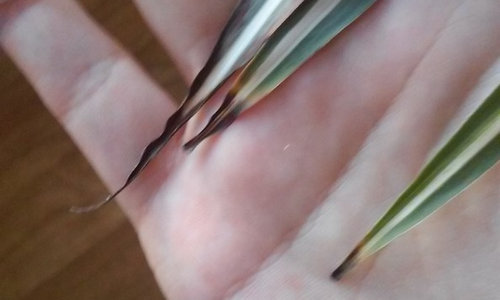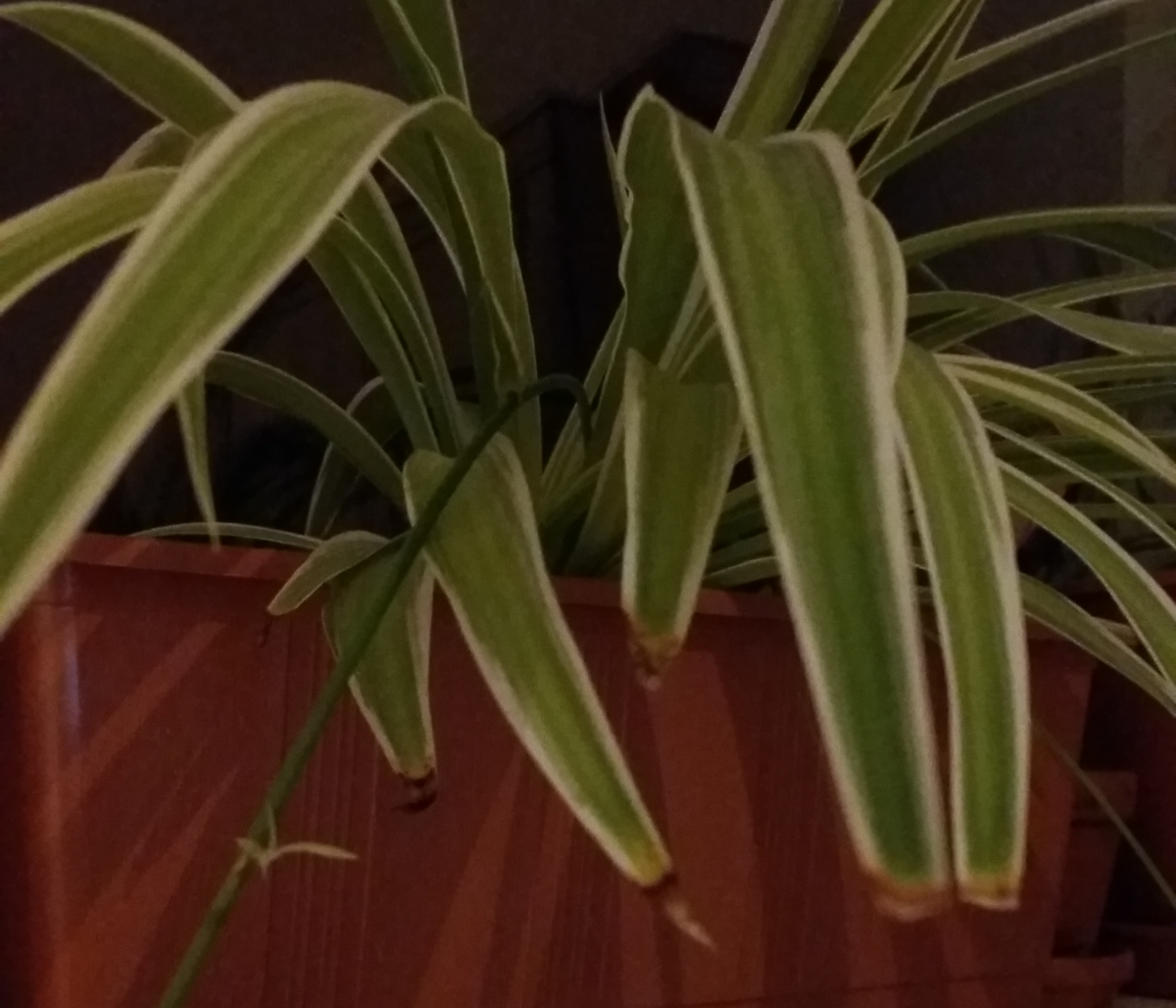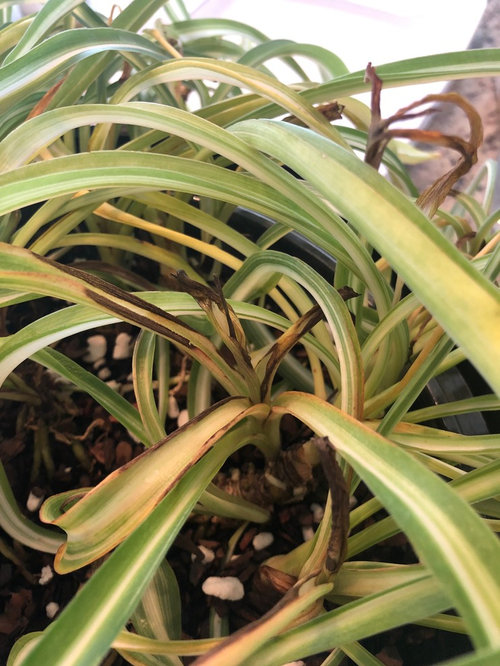When spider plant leaves are exposed to freezing temperatures and frost, they turn black. The frost-sensitive leaves of spider plants frequently turn black when they come into contact with a chilly window indoors. The decay of the roots and fungi brought on by overwatering can also turn the leaves of spider plants black.
Find out why your spider plant’s leaves have turned black by reading on.
Table of Contents
Cold Temperature Cause Black Leaves
As their ideal temperature for growth is approximately room temperature, between 65°F (18°C) and 75°F (23°C) during the day, and warmer than 55°F (12°C) at night, spider plants thrive in the home.
They do not survive cold or frost being hardy to zone 10.
Although spider plants are resistant and tenacious and can withstand brief periods of cold, they begin to exhibit indications of stress when the temperature drops below 55°F (12°C), with their leaves becoming brown or black.
If there is a considerable drop in temperature, such as exposure to frost, spider plant leaves turn noticeably black.
Typically, this occurs as a result of the spider plant’s proximity to a window. On a chilly winter morning, leaves that are in contact with a cold window tend to turn black.
To avoid additional harm, keep your spider plant away from any cold, drafty parts of the house and make sure the leaves are not touching any windows.
Due to the spider plant’s sensitivity to the cold, it is best to remove the afflicted black leaves at the plant’s base rather than waiting for individual leaves to heal.
Root Rot Causes Leaves to Turn Black
Although the spider plant enjoys moist air, it cannot stand for its roots to be in soggy ground.
For spider plants to remain healthy, the soil must be equally moist yet also have good drainage.
To keep the ideal balance of moisture, the top inch of the soil should ideally dry out between watering sessions.
It’s possible for: to produce root rot or other fungal illnesses.
- excessive watering of your spider plant.
- Slow draining soils.
- pots with beautiful outer pots or saucers, trays, or pots without drainage holes in the base that stop water from escaping.
- pots that are large and take a lengthy time to dry out.
If your spider plant has root rot or a fungal illness and the leaves have become black then it is very impossible to restore the plant (unless you can propagate any spiderettes that have developed) therefore prevention is preferable then treatment.
(To learn more, see my article on how to save a dying spider plant.)
How To Prevent Spider Plant Leaves Turning Black
Avoid Over Watering Your Spider Plants
As was previously said, the ideal time to water spider plants is when the top inch of soil feels dry.
This typically entails watering once every 7 to 10 days, though climate can affect this.
Test the soil’s top inch for moisture with your finger to determine how long it takes for it to dry out.
Wait to water if the soil seems damp. This is the ideal time to start watering as soon as the soil starts to feel a little dry.
Through careful watering management, the spider plant gets all the moisture it needs for healthy growth while preventing root rot.
(Read my post to understand the best strategies for watering and important advice for watering spider plants.)
Slow Draining Soils
Although spider plants don’t care much about the type of soil, their potting soil should be permeable and well-draining.
For growing spider plants, standard potting soil works best because it keeps some moisture while allowing extra to drain out from the roots.
Check the bottom of the pot if you see the soil draining slowly after watering since sometimes compacted soil (or roots) can block the drainage in the base of the pot, which prevents water from draining and increases the danger of root rot.
Plant Spider plants in Pots with Drainage Holes in the Base
Your spider plants must be kept in pots or other containers with drainage holes so that any excess water can be let out, keeping the plant healthy.
Without drainage holes, extra water gathers around the roots of the spider plants in decorative pots, which leads to root rot.
Additionally, if saucers and trays that prevent water from leaking in the house are not frequently empty, the soil around the roots of your spider plant may become damp.
Larger Pots Take Longer to Dry Out
The ideal pot size for spider plants is slightly bigger than the root ball.
This encourages the growth of spiderettes, which can be employed for reproduction, as well as flowering.
(For additional information, see my article, Spider Plant Not Growing and Not Producing Babies.)
Larger pots have more soil in them, which means they can hold more moisture.
This implies that a bigger pot may take a lot longer to dry out than a smaller pot, which raises the possibility of root rot.
In order to prevent the soil from staying too wet for too long and causing your spider plant’s leaves to turn black, plant your spider plant in a pot that is appropriate to the size of its root ball.
Key Takeaways:
- When spider plant leaves are subjected to freezing temperatures, they turn black. When exposed to frost, spider plants, which are cold hardy to USDA zone 10, turn black. When exposed to a cold window in the Winter, spider plant leaves frequently turn black.
- At the plant’s base, trim away any spider plant leaves that are dark, cold- or frost-damaged.
- Root rot and other fungi can cause spider plants to turn black. Overwatering, poorly draining soils, and pots without drainage holes can contribute to root rot.
- Never put spider plants in containers without drainage holes, and only water them after the top inch of soil has dried off. In order to prevent root rot, regularly empty saucers and trays of extra water.
FAQ
What happens when you overwater a spider plant?
The blackening or darkening of spider plant leaves is caused by overwatering. The soil needs to somewhat dry out in between irrigations. Spider plants shouldn’t be allowed to entirely dry out because it would only provide more gasoline to the fire.
Should I cut the brown tips off my spider plant?
Should I Trim My Spider Plants’ Brown Tips? No, you are not required to remove the brown tips, but you are welcome to do so. The plant is not harmed or damaged by brown tips on their own. They are just dried-out, sometimes papery to the touch, dead plant tissue that falls off when touched.
How do you tell if spider plant is overwatered or Underwatered?
The soil of your spider plant will appear dark and feel moist or soggy if it is overwatered. On top of the soil, mold, mildew, and other fungal growths can develop. An under-watered plant, on the other hand, will have light, dry soil.
Why are the ends of my spider plant Brown?
The blackening or darkening of spider plant leaves is caused by overwatering. The soil needs to somewhat dry out in between irrigations. Spider plants shouldn’t be allowed to entirely dry out because it would only provide more gasoline to the fire. The foliage will begin to get discolored if there is not enough moisture, starting at the tips.



